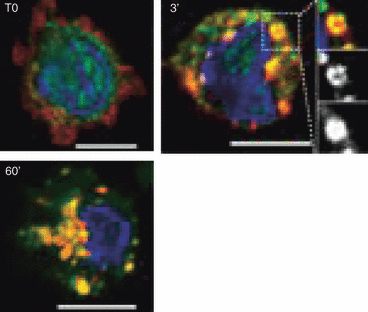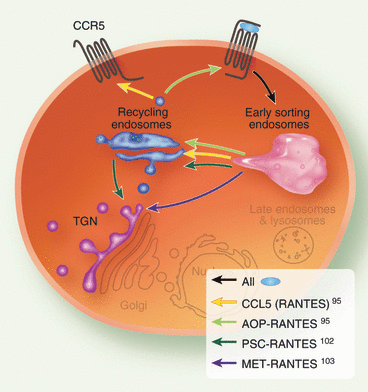Mechanisms regulating chemokine receptor activity
- PMID: 21977995
- PMCID: PMC3209565
- DOI: 10.1111/j.1365-2567.2011.03485.x
Mechanisms regulating chemokine receptor activity
Abstract
Co-ordinated movement and controlled positioning of leucocytes is key to the development, maintenance and proper functioning of the immune system. Chemokines and their receptors play an essential role in these events by mediating directed cell migration, often referred to as chemotaxis. The chemotactic property of these molecules is also thought to contribute to an array of pathologies where inappropriate recruitment of specific chemokine receptor-expressing leucocytes is observed, including cancer and inflammatory diseases. As a result, chemokine receptors have become major targets for therapeutic intervention, and during the past 15 years much research has been devoted to understanding the regulation of their biological activity. From these studies, processes which govern the availability of functional chemokine receptors at the cell surface have emerged as playing a central role. In this review, we summarize and discuss current knowledge on the molecular mechanisms contributing to the regulation of chemokine receptor surface expression, from gene transcription and protein degradation to post-translational modifications, multimerization, intracellular transport and cross-talk.
© 2011 The Authors. Immunology © 2011 Blackwell Publishing Ltd.
Figures



Similar articles
-
Mechanisms of Regulation of the Chemokine-Receptor Network.Int J Mol Sci. 2017 Feb 7;18(2):342. doi: 10.3390/ijms18020342. Int J Mol Sci. 2017. PMID: 28178200 Free PMC article. Review.
-
A guide to chemokines and their receptors.FEBS J. 2018 Aug;285(16):2944-2971. doi: 10.1111/febs.14466. Epub 2018 Apr 24. FEBS J. 2018. PMID: 29637711 Free PMC article. Review.
-
Overview of the mechanisms regulating chemokine activity and availability.Immunol Lett. 2012 Jul 30;145(1-2):2-9. doi: 10.1016/j.imlet.2012.04.015. Immunol Lett. 2012. PMID: 22698177 Review.
-
Targeting chemokine receptors in allergic disease.Biochem J. 2011 Feb 15;434(1):11-24. doi: 10.1042/BJ20101132. Biochem J. 2011. PMID: 21269275 Review.
-
Chemokine receptor oligomerization: functional considerations.Curr Opin Pharmacol. 2010 Feb;10(1):38-43. doi: 10.1016/j.coph.2009.09.004. Epub 2009 Oct 12. Curr Opin Pharmacol. 2010. PMID: 19828377 Review.
Cited by
-
A correlative and quantitative imaging approach enabling characterization of primary cell-cell communication: Case of human CD4+ T cell-macrophage immunological synapses.Sci Rep. 2018 May 22;8(1):8003. doi: 10.1038/s41598-018-26172-3. Sci Rep. 2018. PMID: 29789661 Free PMC article.
-
Blocking activation of CD4-CD8- T cells modulates their cytotoxic potential and decreases the expression of inflammatory and chemotactic receptors.Clin Immunol. 2023 Jun;251:109331. doi: 10.1016/j.clim.2023.109331. Epub 2023 Apr 23. Clin Immunol. 2023. PMID: 37088297 Free PMC article.
-
Simulating CXCR5 Dynamics in Complex Tissue Microenvironments.Front Immunol. 2021 Sep 7;12:703088. doi: 10.3389/fimmu.2021.703088. eCollection 2021. Front Immunol. 2021. PMID: 34557191 Free PMC article.
-
Revisiting the role of interleukin-8 in chronic lymphocytic leukemia.Sci Rep. 2017 Nov 16;7(1):15714. doi: 10.1038/s41598-017-15953-x. Sci Rep. 2017. PMID: 29146966 Free PMC article.
-
Low CXCL11 expression is indicative of poor prognosis in rectal cancer patients undergoing preoperative chemoradiotherapy: a retrospective cohort study.Virchows Arch. 2025 Apr;486(4):803-815. doi: 10.1007/s00428-024-03974-7. Epub 2024 Nov 27. Virchows Arch. 2025. PMID: 39592484 Free PMC article.
References
-
- IUIS/WHO subcommittee on chemokine nomenclature Chemokine/chemokine receptor nomenclature. Cytokine. 2003;21:48–9. - PubMed
-
- Murphy PM, Tiffany HL. Cloning of complementary DNA encoding a functional human interleukin-8 receptor. Science. 1991;253:1280–3. - PubMed
-
- Schall TJ, Proudfoot AE. Overcoming hurdles in developing successful drugs targeting chemokine receptors. Nat Rev Immunol. 2011;11:355–63. - PubMed
-
- Zidar DA. Endogenous ligand bias by chemokines: implications at the front lines of infection and leukocyte trafficking. Endocr Metab Immune Disord Drug Targets. 2011;11:120–31. - PubMed
-
- Borroni EM, Mantovani A, Locati M, Bonecchi R. Chemokine receptors intracellular trafficking. Pharmacol Ther. 2010;127:1–8. - PubMed
Publication types
MeSH terms
Substances
Grants and funding
LinkOut - more resources
Full Text Sources
Research Materials
Miscellaneous

